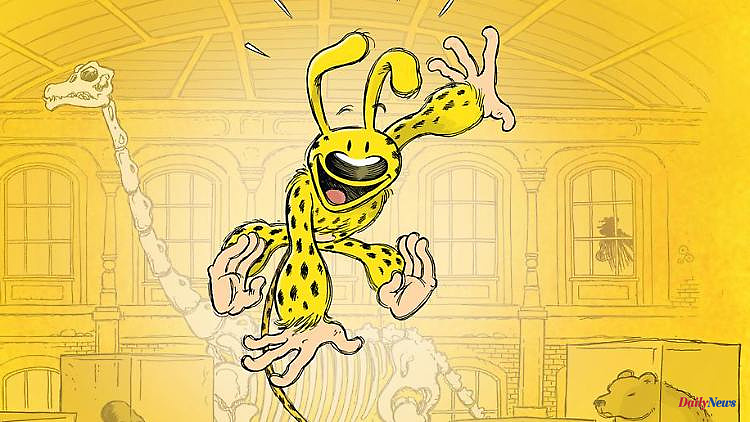Hitler also gets a headbutt: The Marsupilami makes Berlin in 1931 unsafe in "The Humboldt Animal". After his "Spirou" band, Flix draws an animal superhero this time - and entertains all ages.
Of the animal classics of Franco-Belgian comics, the Marsupilami is undoubtedly the strangest. Sure, there are Struppi, Idefix and Jolly Jumper, who have to help their companions Tim, Obelix and Lucky Luke over and over again. The Marsupilami, however, cannot be said by anyone. Not even from Spirou or Fantasio, in whose adventures the animal first appeared - 70 years ago, in January 1952.
Since then, the Marsupilami - known to his fans as Marsu - has been fighting crooks and villains, sometimes alone, sometimes alongside Spirou. And the readers learn a lot about the yellow fantasy animal with the black dots: that it comes from Palumbia in South America, eats fruit but also likes piranhas, that it lays eggs, has a limited vocabulary ("Huba! Huba!" ) and has a tail that can be up to eight meters long. And with this tail it not only swings through the jungle and helps people in need, but also likes to knock out its enemies.
"The Marsupilami is a superhero with many abilities," Flix puts it in a nutshell. The award-winning draftsman, whose real name is Felix Görmann, is familiar with the Spirou universe. In 2018 he was the first German to present his version of the comic classic, in "Spirou in Berlin". Now follows his first Marsupilami volume, "The Humboldt Animal", published by Carlsen. Flix follows in the footsteps of one of the greatest Franco-Belgian comic artists: André Franquin. He invented the Marsupilami and repeatedly included it in his Spirou albums, later there were solo adventures drawn by Bartem, now in a good three dozen volumes.
But Franquin left his successors no easy task: "It's just an incredible amount of work to draw the Marsupilami, it's a drawing challenge," says Flix, alluding to the animal's long tail. At the same time, however, there are infinitely many display options. "That, in turn, is great. You just have to walk the extra eight meters," he says with a laugh.
Flix went the extra way - and presents an album whose strength lies in the different levels with which the adventure can be read. It begins in December 1801, in the remote parts of South America. Alexander von Humboldt and his companion Aimé Bonpland are on a big expedition when they meet the Marsupilami. After a hunt through the jungle, they manage to catch the animal and its eggs and pack them in a box and take them home.
Zeitsprung, Berlin in 1931: Little Mimmi is allowed to help Otto, a friend of her mother's, in the natural history museum. He works in the archive and stuffs animals. While romping around, Mimmi finds a box that Humboldt once brought back from America, but which has remained undiscovered for 130 years. Inside, no surprise: the Marsupilami, which has survived the passage of time unscathed thanks to a mummy who also traveled with it. A wild hunt begins, because the marsupilami not only wants to find its three eggs with the offspring, but also to go home to its jungle.
But first you have to conquer the urban jungle. The location is cleverly chosen: at the beginning of the 1930s, Berlin was one of the most densely populated metropolises in the world. "I wanted to put the Marsupilami in a modern world where it's difficult to find your way around," Flix explains the concept. In return, he also accepted the leap in time that ends the action-packed, twelve-page story about Humboldt and comes along a bit abruptly when reading it - one would have liked to have continued to follow the footsteps of the great researcher.
Then again: Humboldt would have been just another man in the Spirou universe. And Flix wanted to avoid that, as he did in his Spirou volume, where he put the young woman Momo at the side of the title hero. "If you look at classic comic series made in the Franquin era, the main characters tend to be male. It's time to break that up." When designing the volume, he also thought about a boy as the main character. "But then I realized: You don't need that, just like the classic setting father, mother, child." Instead, Mimmi lives alone with her mother - which the neighbors comment disparagingly.
This is also where the different levels come into play, which Flix cleverly plays with. "I found that the Marsupilami works in all age groups," says the artist. "The first readers can do something with it, but also the older ones on a different level. And even older readers who used to read 'Fix und Foxi' are addressed." He wanted to draw a story that offers something for everyone.
For young readers, the volume is about the wild hunt through Berlin in search of Marsupilami's eggs. There are simple puns and lots of funny slapstick moments that even non-readers will understand. However, the older the audience gets, the more details they will discover: the unusual family constellation, the hostile environment that Mimmi and her mother are exposed to, precarious living conditions that are reminiscent of the works of Hans Fallada, political jokes and National Socialists who died in 1931 street scene - and get a beating on the cap from the Marsupilami.
Finally, attentive readers will also notice that Mimmi is Jewish, which Flix only reveals through the smallest allusions, but gives the story a completely different, dramatic effect in view of the events to come. "It's not a good time and you can tell that society is tipping over," says Flix. He also sees a parallel to the present in this: "I would like to point out in the story that something foreign can also be an enrichment that makes life more beautiful and the people who deal with it stronger." In the end - so much can be said - he also gives this strength to Mimmi on the way. But no doubt one wonders when reading what happened to daughter and mother under National Socialism.
"The Humboldt Animal" is a successful volume, even if it doesn't reach the complexity and depth of "Spirou in Berlin". This is due to the tone of the "Marsupilami" series, which is aimed more at children with its slapstick interludes, simple puns and teeming pictures. But the many details and allusions - Spirou himself can also be discovered - as well as the constantly surprising page design also keep adult readers interested.
By the way: Flix originally wanted to set the main story in Berlin at the beginning of the 1950s in order to connect to the first appearance in 1952. But he shelved this idea, also because a Marsupilami volume was recently published that plays exactly in this period: "The Beast" by Zidrou and Frank Pé is not a funny adventure, but a dramatic one told in realistic images, yes downright dark story aimed at an adult audience.
Flix will present the book throughout Germany in September and October. The dates are here.












